MIT Project Proposal: Fog/Edge Computing to Improve Human Livelihood
VerifiedAdded on 2023/06/03
|17
|3487
|307
Project
AI Summary
This project proposal explores the integration of Fog and Edge computing with Cloud technology to enhance the Internet of Things (IoT) and improve societal livelihood. It addresses the challenges of network bandwidth and cloud dependency in IoT applications by proposing a hybrid platform that leverages local computation and storage capabilities of edge devices. The study aims to reduce cloud resource access, global internet traffic, and design complexity while improving application fault tolerance and quality of service (QoS). The proposal outlines research questions, literature review, methodology based on design science, and a schedule for achieving the project objectives, including the identification of resource requirements for IoT applications and the evaluation of existing cloud-based IoT systems. The ultimate goal is to create a functional hybrid platform with a common API for various IoT applications.
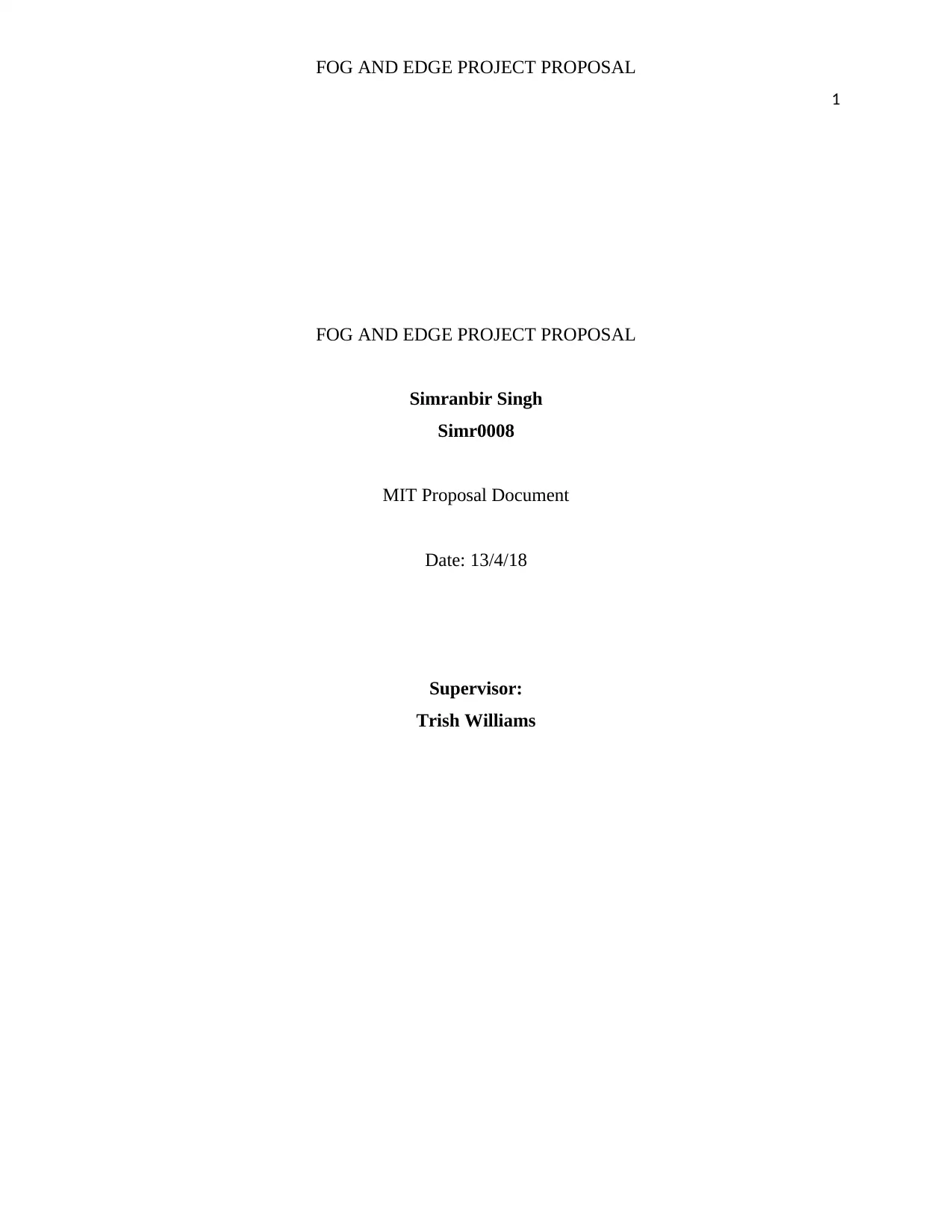
FOG AND EDGE PROJECT PROPOSAL
1
FOG AND EDGE PROJECT PROPOSAL
Simranbir Singh
Simr0008
MIT Proposal Document
Date: 13/4/18
Supervisor:
Trish Williams
1
FOG AND EDGE PROJECT PROPOSAL
Simranbir Singh
Simr0008
MIT Proposal Document
Date: 13/4/18
Supervisor:
Trish Williams
Paraphrase This Document
Need a fresh take? Get an instant paraphrase of this document with our AI Paraphraser
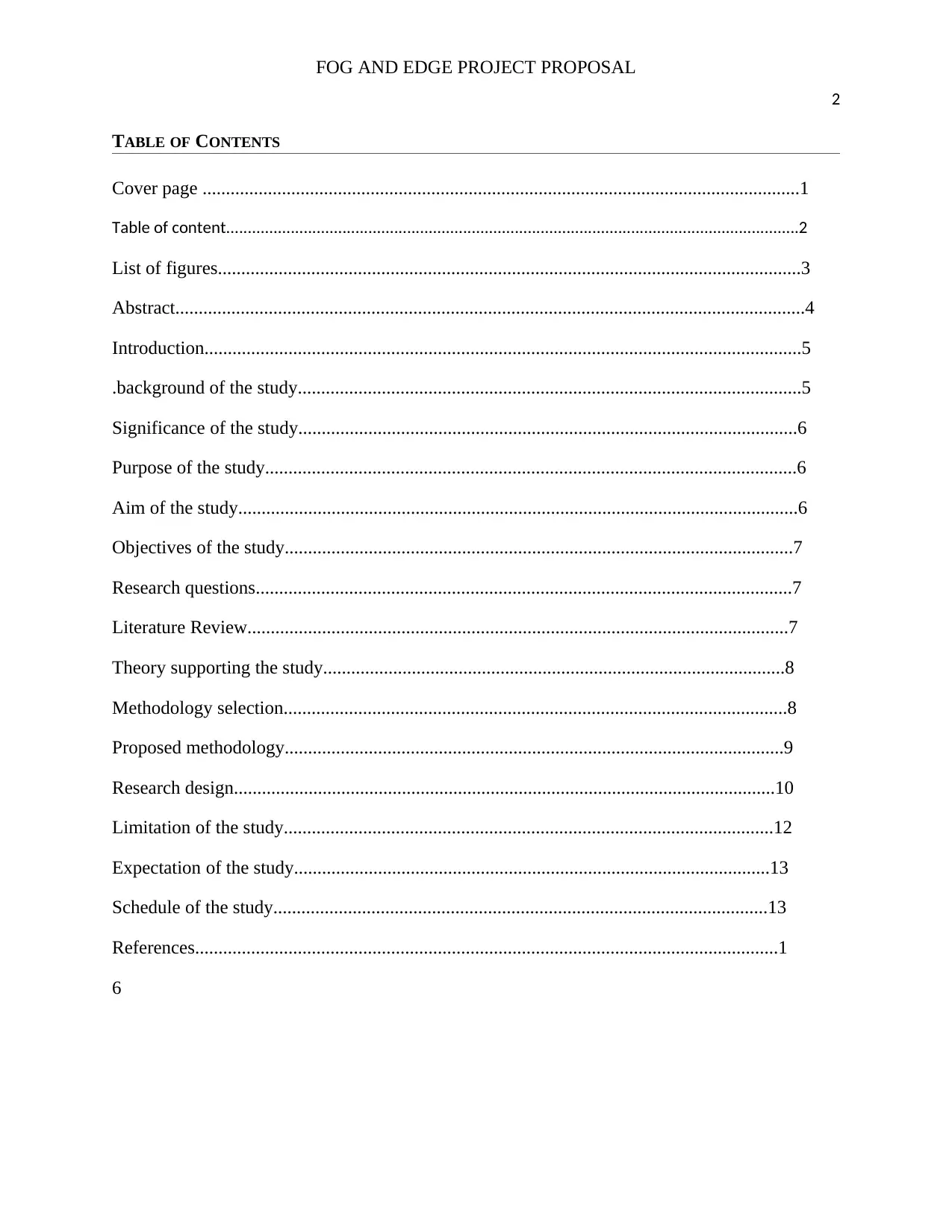
FOG AND EDGE PROJECT PROPOSAL
2
TABLE OF CONTENTS
Cover page ................................................................................................................................1
Table of content.....................................................................................................................................2
List of figures.............................................................................................................................3
Abstract.......................................................................................................................................4
Introduction................................................................................................................................5
.background of the study............................................................................................................5
Significance of the study...........................................................................................................6
Purpose of the study..................................................................................................................6
Aim of the study........................................................................................................................6
Objectives of the study.............................................................................................................7
Research questions...................................................................................................................7
Literature Review....................................................................................................................7
Theory supporting the study...................................................................................................8
Methodology selection............................................................................................................8
Proposed methodology...........................................................................................................9
Research design....................................................................................................................10
Limitation of the study.........................................................................................................12
Expectation of the study......................................................................................................13
Schedule of the study..........................................................................................................13
References.............................................................................................................................1
6
2
TABLE OF CONTENTS
Cover page ................................................................................................................................1
Table of content.....................................................................................................................................2
List of figures.............................................................................................................................3
Abstract.......................................................................................................................................4
Introduction................................................................................................................................5
.background of the study............................................................................................................5
Significance of the study...........................................................................................................6
Purpose of the study..................................................................................................................6
Aim of the study........................................................................................................................6
Objectives of the study.............................................................................................................7
Research questions...................................................................................................................7
Literature Review....................................................................................................................7
Theory supporting the study...................................................................................................8
Methodology selection............................................................................................................8
Proposed methodology...........................................................................................................9
Research design....................................................................................................................10
Limitation of the study.........................................................................................................12
Expectation of the study......................................................................................................13
Schedule of the study..........................................................................................................13
References.............................................................................................................................1
6
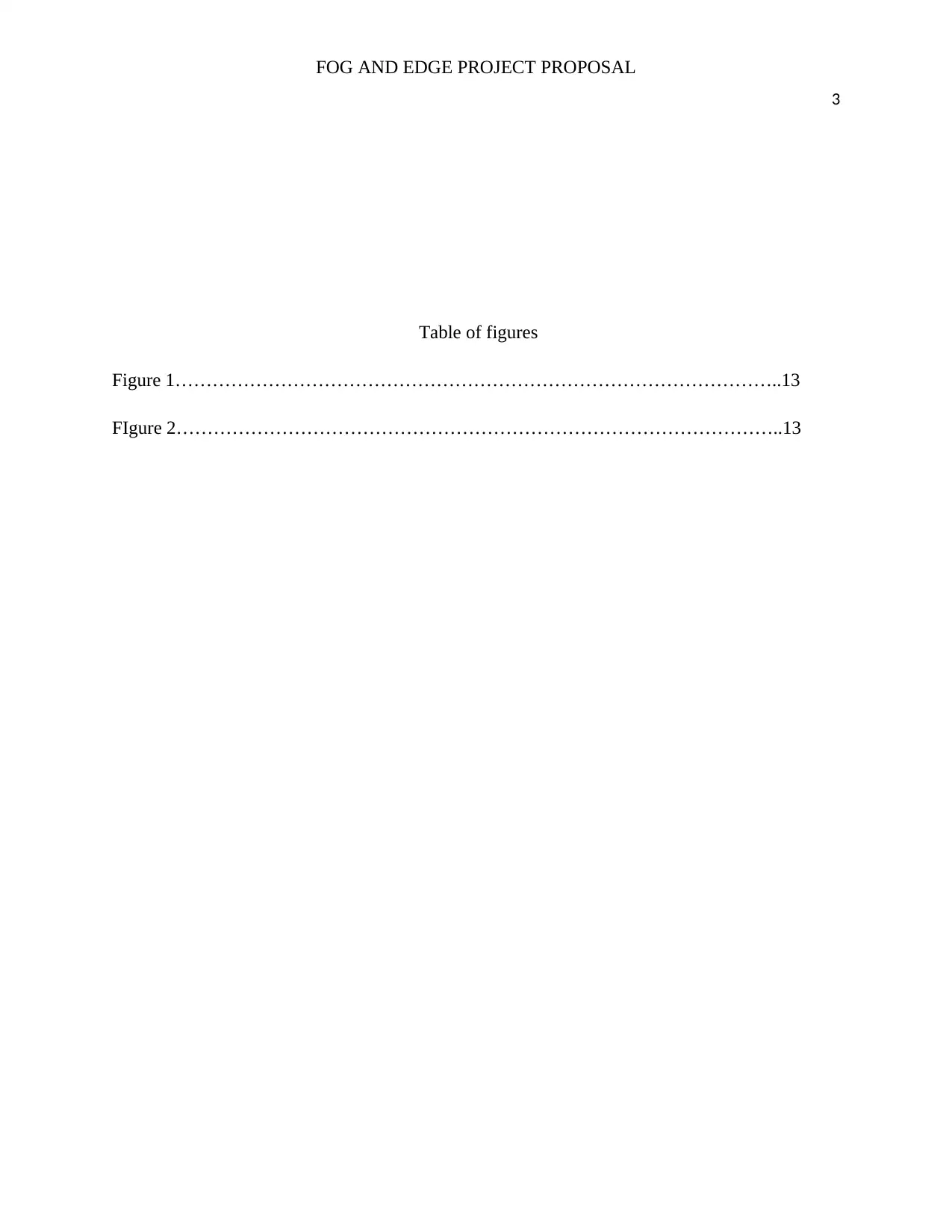
FOG AND EDGE PROJECT PROPOSAL
3
Table of figures
Figure 1……………………………………………………………………………………..13
FIgure 2……………………………………………………………………………………..13
3
Table of figures
Figure 1……………………………………………………………………………………..13
FIgure 2……………………………………………………………………………………..13
⊘ This is a preview!⊘
Do you want full access?
Subscribe today to unlock all pages.

Trusted by 1+ million students worldwide
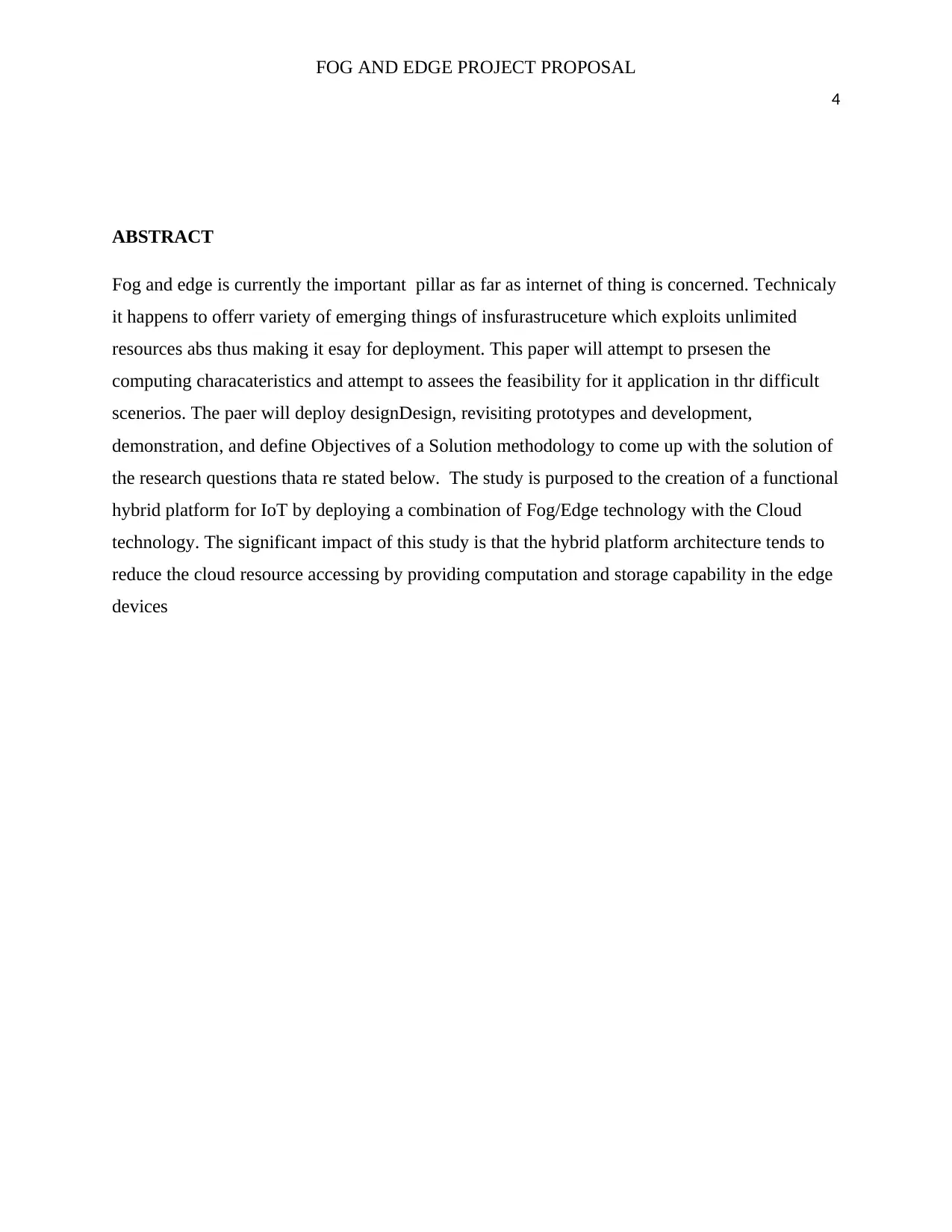
FOG AND EDGE PROJECT PROPOSAL
4
ABSTRACT
Fog and edge is currently the important pillar as far as internet of thing is concerned. Technicaly
it happens to offerr variety of emerging things of insfurastruceture which exploits unlimited
resources abs thus making it esay for deployment. This paper will attempt to prsesen the
computing characateristics and attempt to assees the feasibility for it application in thr difficult
scenerios. The paer will deploy designDesign, revisiting prototypes and development,
demonstration, and define Objectives of a Solution methodology to come up with the solution of
the research questions thata re stated below. The study is purposed to the creation of a functional
hybrid platform for IoT by deploying a combination of Fog/Edge technology with the Cloud
technology. The significant impact of this study is that the hybrid platform architecture tends to
reduce the cloud resource accessing by providing computation and storage capability in the edge
devices
4
ABSTRACT
Fog and edge is currently the important pillar as far as internet of thing is concerned. Technicaly
it happens to offerr variety of emerging things of insfurastruceture which exploits unlimited
resources abs thus making it esay for deployment. This paper will attempt to prsesen the
computing characateristics and attempt to assees the feasibility for it application in thr difficult
scenerios. The paer will deploy designDesign, revisiting prototypes and development,
demonstration, and define Objectives of a Solution methodology to come up with the solution of
the research questions thata re stated below. The study is purposed to the creation of a functional
hybrid platform for IoT by deploying a combination of Fog/Edge technology with the Cloud
technology. The significant impact of this study is that the hybrid platform architecture tends to
reduce the cloud resource accessing by providing computation and storage capability in the edge
devices
Paraphrase This Document
Need a fresh take? Get an instant paraphrase of this document with our AI Paraphraser
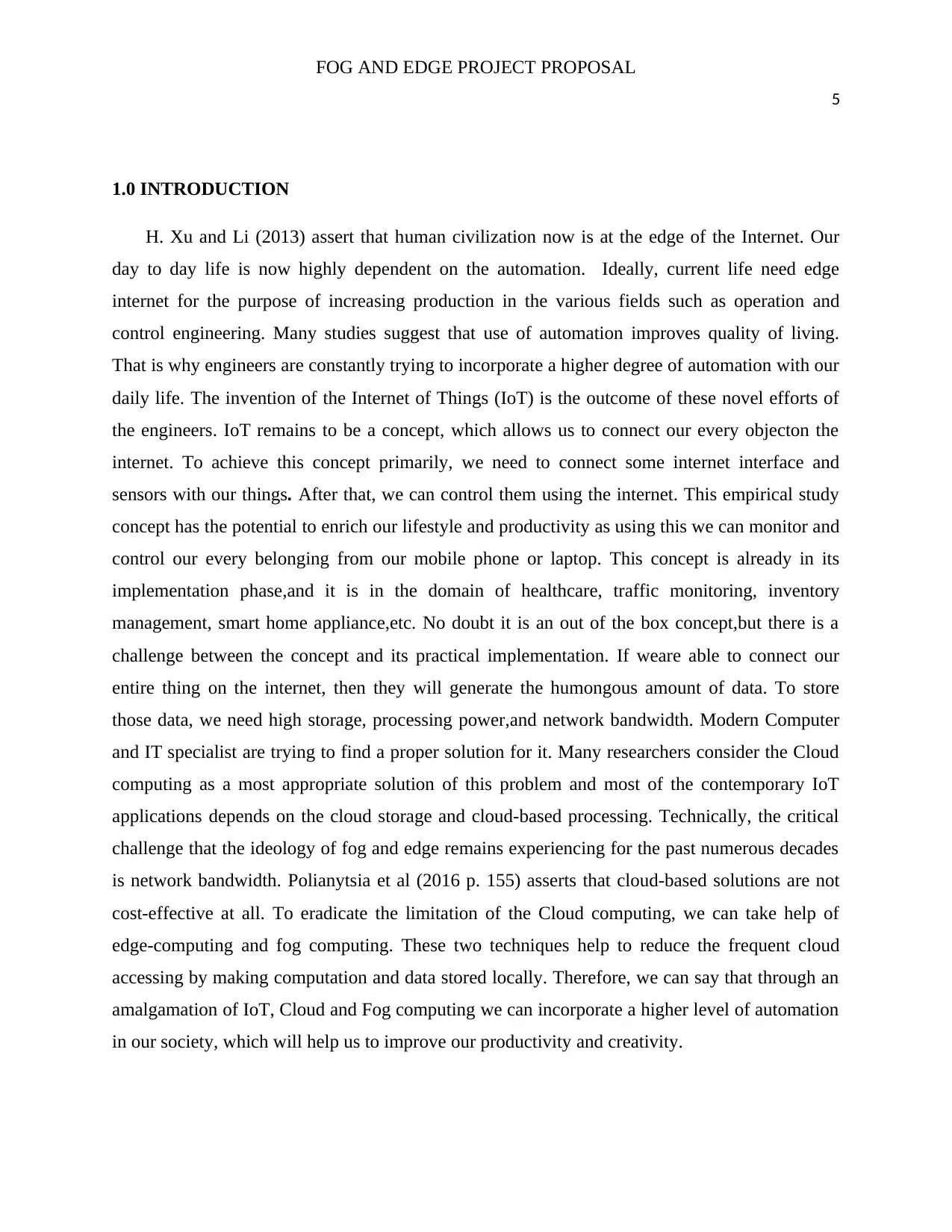
FOG AND EDGE PROJECT PROPOSAL
5
1.0 INTRODUCTION
H. Xu and Li (2013) assert that human civilization now is at the edge of the Internet. Our
day to day life is now highly dependent on the automation. Ideally, current life need edge
internet for the purpose of increasing production in the various fields such as operation and
control engineering. Many studies suggest that use of automation improves quality of living.
That is why engineers are constantly trying to incorporate a higher degree of automation with our
daily life. The invention of the Internet of Things (IoT) is the outcome of these novel efforts of
the engineers. IoT remains to be a concept, which allows us to connect our every objecton the
internet. To achieve this concept primarily, we need to connect some internet interface and
sensors with our things. After that, we can control them using the internet. This empirical study
concept has the potential to enrich our lifestyle and productivity as using this we can monitor and
control our every belonging from our mobile phone or laptop. This concept is already in its
implementation phase,and it is in the domain of healthcare, traffic monitoring, inventory
management, smart home appliance,etc. No doubt it is an out of the box concept,but there is a
challenge between the concept and its practical implementation. If weare able to connect our
entire thing on the internet, then they will generate the humongous amount of data. To store
those data, we need high storage, processing power,and network bandwidth. Modern Computer
and IT specialist are trying to find a proper solution for it. Many researchers consider the Cloud
computing as a most appropriate solution of this problem and most of the contemporary IoT
applications depends on the cloud storage and cloud-based processing. Technically, the critical
challenge that the ideology of fog and edge remains experiencing for the past numerous decades
is network bandwidth. Polianytsia et al (2016 p. 155) asserts that cloud-based solutions are not
cost-effective at all. To eradicate the limitation of the Cloud computing, we can take help of
edge-computing and fog computing. These two techniques help to reduce the frequent cloud
accessing by making computation and data stored locally. Therefore, we can say that through an
amalgamation of IoT, Cloud and Fog computing we can incorporate a higher level of automation
in our society, which will help us to improve our productivity and creativity.
5
1.0 INTRODUCTION
H. Xu and Li (2013) assert that human civilization now is at the edge of the Internet. Our
day to day life is now highly dependent on the automation. Ideally, current life need edge
internet for the purpose of increasing production in the various fields such as operation and
control engineering. Many studies suggest that use of automation improves quality of living.
That is why engineers are constantly trying to incorporate a higher degree of automation with our
daily life. The invention of the Internet of Things (IoT) is the outcome of these novel efforts of
the engineers. IoT remains to be a concept, which allows us to connect our every objecton the
internet. To achieve this concept primarily, we need to connect some internet interface and
sensors with our things. After that, we can control them using the internet. This empirical study
concept has the potential to enrich our lifestyle and productivity as using this we can monitor and
control our every belonging from our mobile phone or laptop. This concept is already in its
implementation phase,and it is in the domain of healthcare, traffic monitoring, inventory
management, smart home appliance,etc. No doubt it is an out of the box concept,but there is a
challenge between the concept and its practical implementation. If weare able to connect our
entire thing on the internet, then they will generate the humongous amount of data. To store
those data, we need high storage, processing power,and network bandwidth. Modern Computer
and IT specialist are trying to find a proper solution for it. Many researchers consider the Cloud
computing as a most appropriate solution of this problem and most of the contemporary IoT
applications depends on the cloud storage and cloud-based processing. Technically, the critical
challenge that the ideology of fog and edge remains experiencing for the past numerous decades
is network bandwidth. Polianytsia et al (2016 p. 155) asserts that cloud-based solutions are not
cost-effective at all. To eradicate the limitation of the Cloud computing, we can take help of
edge-computing and fog computing. These two techniques help to reduce the frequent cloud
accessing by making computation and data stored locally. Therefore, we can say that through an
amalgamation of IoT, Cloud and Fog computing we can incorporate a higher level of automation
in our society, which will help us to improve our productivity and creativity.
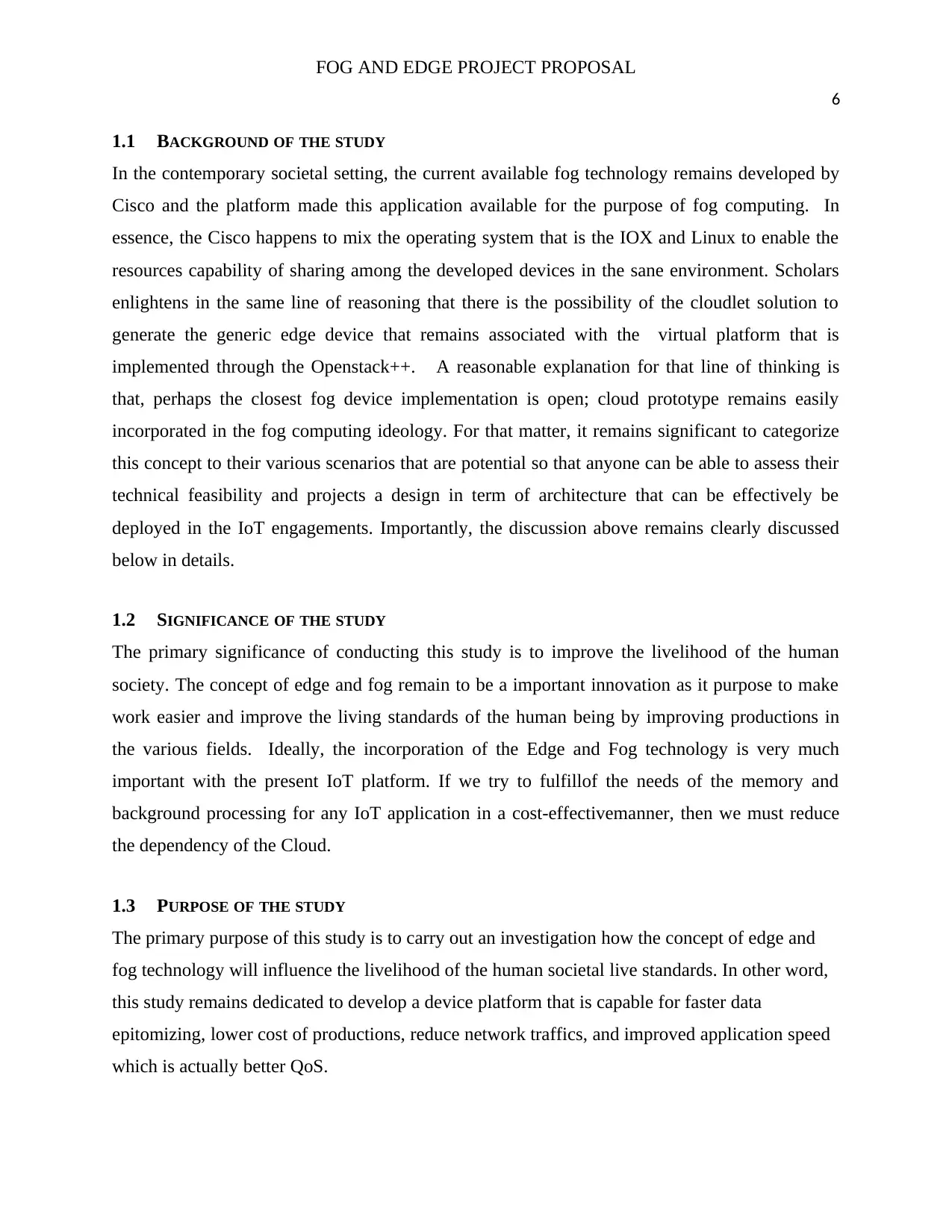
FOG AND EDGE PROJECT PROPOSAL
6
1.1 BACKGROUND OF THE STUDY
In the contemporary societal setting, the current available fog technology remains developed by
Cisco and the platform made this application available for the purpose of fog computing. In
essence, the Cisco happens to mix the operating system that is the IOX and Linux to enable the
resources capability of sharing among the developed devices in the sane environment. Scholars
enlightens in the same line of reasoning that there is the possibility of the cloudlet solution to
generate the generic edge device that remains associated with the virtual platform that is
implemented through the Openstack++. A reasonable explanation for that line of thinking is
that, perhaps the closest fog device implementation is open; cloud prototype remains easily
incorporated in the fog computing ideology. For that matter, it remains significant to categorize
this concept to their various scenarios that are potential so that anyone can be able to assess their
technical feasibility and projects a design in term of architecture that can be effectively be
deployed in the IoT engagements. Importantly, the discussion above remains clearly discussed
below in details.
1.2 SIGNIFICANCE OF THE STUDY
The primary significance of conducting this study is to improve the livelihood of the human
society. The concept of edge and fog remain to be a important innovation as it purpose to make
work easier and improve the living standards of the human being by improving productions in
the various fields. Ideally, the incorporation of the Edge and Fog technology is very much
important with the present IoT platform. If we try to fulfillof the needs of the memory and
background processing for any IoT application in a cost-effectivemanner, then we must reduce
the dependency of the Cloud.
1.3 PURPOSE OF THE STUDY
The primary purpose of this study is to carry out an investigation how the concept of edge and
fog technology will influence the livelihood of the human societal live standards. In other word,
this study remains dedicated to develop a device platform that is capable for faster data
epitomizing, lower cost of productions, reduce network traffics, and improved application speed
which is actually better QoS.
6
1.1 BACKGROUND OF THE STUDY
In the contemporary societal setting, the current available fog technology remains developed by
Cisco and the platform made this application available for the purpose of fog computing. In
essence, the Cisco happens to mix the operating system that is the IOX and Linux to enable the
resources capability of sharing among the developed devices in the sane environment. Scholars
enlightens in the same line of reasoning that there is the possibility of the cloudlet solution to
generate the generic edge device that remains associated with the virtual platform that is
implemented through the Openstack++. A reasonable explanation for that line of thinking is
that, perhaps the closest fog device implementation is open; cloud prototype remains easily
incorporated in the fog computing ideology. For that matter, it remains significant to categorize
this concept to their various scenarios that are potential so that anyone can be able to assess their
technical feasibility and projects a design in term of architecture that can be effectively be
deployed in the IoT engagements. Importantly, the discussion above remains clearly discussed
below in details.
1.2 SIGNIFICANCE OF THE STUDY
The primary significance of conducting this study is to improve the livelihood of the human
society. The concept of edge and fog remain to be a important innovation as it purpose to make
work easier and improve the living standards of the human being by improving productions in
the various fields. Ideally, the incorporation of the Edge and Fog technology is very much
important with the present IoT platform. If we try to fulfillof the needs of the memory and
background processing for any IoT application in a cost-effectivemanner, then we must reduce
the dependency of the Cloud.
1.3 PURPOSE OF THE STUDY
The primary purpose of this study is to carry out an investigation how the concept of edge and
fog technology will influence the livelihood of the human societal live standards. In other word,
this study remains dedicated to develop a device platform that is capable for faster data
epitomizing, lower cost of productions, reduce network traffics, and improved application speed
which is actually better QoS.
⊘ This is a preview!⊘
Do you want full access?
Subscribe today to unlock all pages.

Trusted by 1+ million students worldwide
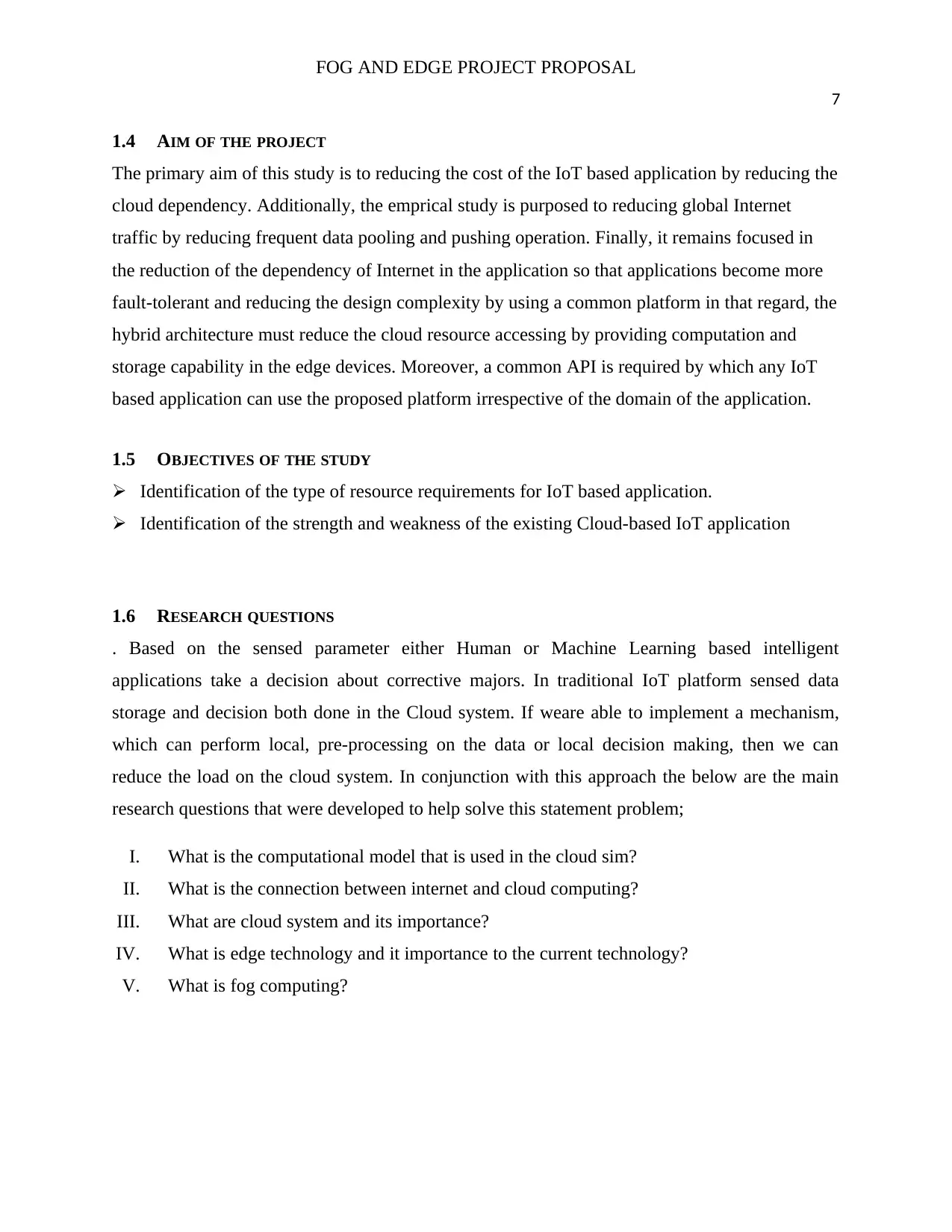
FOG AND EDGE PROJECT PROPOSAL
7
1.4 AIM OF THE PROJECT
The primary aim of this study is to reducing the cost of the IoT based application by reducing the
cloud dependency. Additionally, the emprical study is purposed to reducing global Internet
traffic by reducing frequent data pooling and pushing operation. Finally, it remains focused in
the reduction of the dependency of Internet in the application so that applications become more
fault-tolerant and reducing the design complexity by using a common platform in that regard, the
hybrid architecture must reduce the cloud resource accessing by providing computation and
storage capability in the edge devices. Moreover, a common API is required by which any IoT
based application can use the proposed platform irrespective of the domain of the application.
1.5 OBJECTIVES OF THE STUDY
Identification of the type of resource requirements for IoT based application.
Identification of the strength and weakness of the existing Cloud-based IoT application
1.6 RESEARCH QUESTIONS
. Based on the sensed parameter either Human or Machine Learning based intelligent
applications take a decision about corrective majors. In traditional IoT platform sensed data
storage and decision both done in the Cloud system. If weare able to implement a mechanism,
which can perform local, pre-processing on the data or local decision making, then we can
reduce the load on the cloud system. In conjunction with this approach the below are the main
research questions that were developed to help solve this statement problem;
I. What is the computational model that is used in the cloud sim?
II. What is the connection between internet and cloud computing?
III. What are cloud system and its importance?
IV. What is edge technology and it importance to the current technology?
V. What is fog computing?
7
1.4 AIM OF THE PROJECT
The primary aim of this study is to reducing the cost of the IoT based application by reducing the
cloud dependency. Additionally, the emprical study is purposed to reducing global Internet
traffic by reducing frequent data pooling and pushing operation. Finally, it remains focused in
the reduction of the dependency of Internet in the application so that applications become more
fault-tolerant and reducing the design complexity by using a common platform in that regard, the
hybrid architecture must reduce the cloud resource accessing by providing computation and
storage capability in the edge devices. Moreover, a common API is required by which any IoT
based application can use the proposed platform irrespective of the domain of the application.
1.5 OBJECTIVES OF THE STUDY
Identification of the type of resource requirements for IoT based application.
Identification of the strength and weakness of the existing Cloud-based IoT application
1.6 RESEARCH QUESTIONS
. Based on the sensed parameter either Human or Machine Learning based intelligent
applications take a decision about corrective majors. In traditional IoT platform sensed data
storage and decision both done in the Cloud system. If weare able to implement a mechanism,
which can perform local, pre-processing on the data or local decision making, then we can
reduce the load on the cloud system. In conjunction with this approach the below are the main
research questions that were developed to help solve this statement problem;
I. What is the computational model that is used in the cloud sim?
II. What is the connection between internet and cloud computing?
III. What are cloud system and its importance?
IV. What is edge technology and it importance to the current technology?
V. What is fog computing?
Paraphrase This Document
Need a fresh take? Get an instant paraphrase of this document with our AI Paraphraser
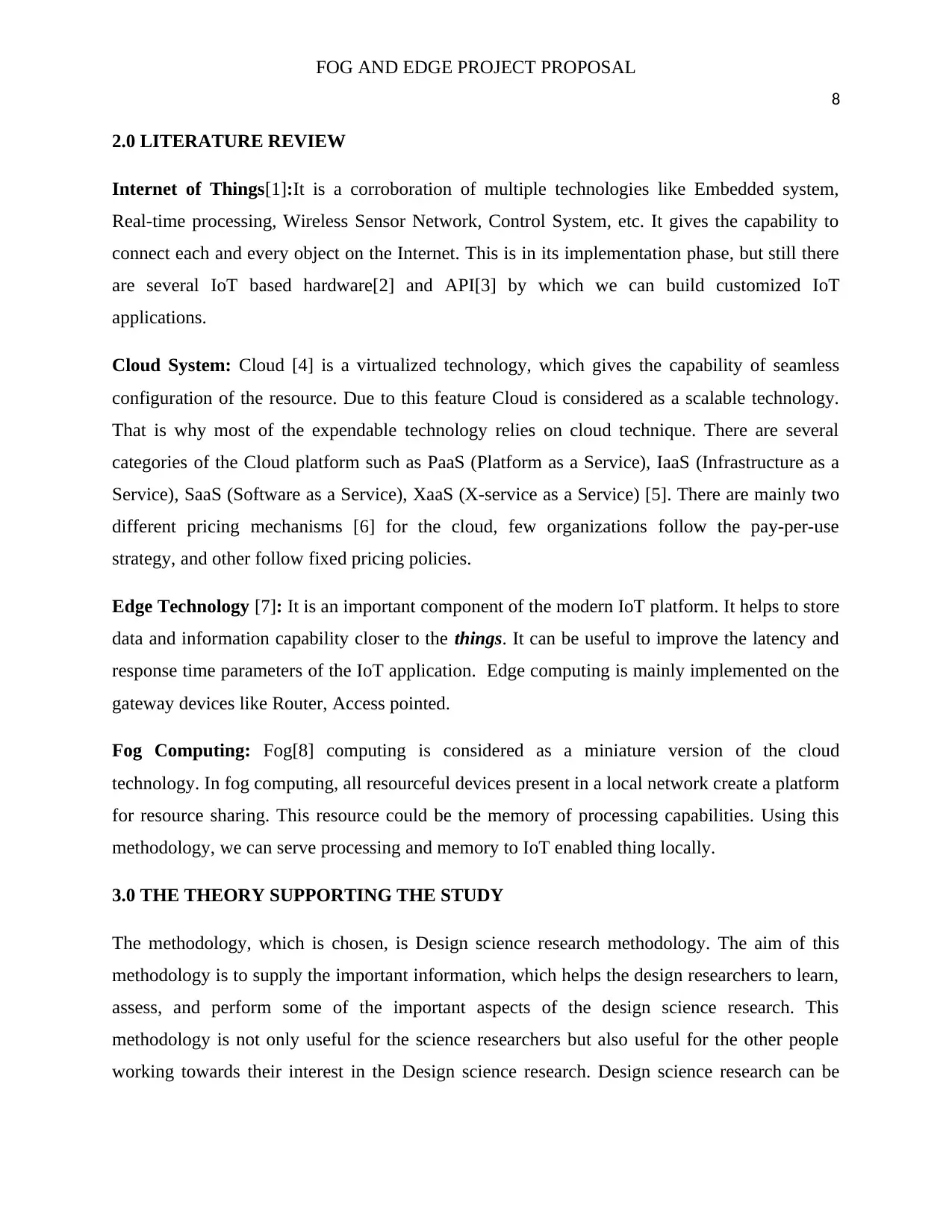
FOG AND EDGE PROJECT PROPOSAL
8
2.0 LITERATURE REVIEW
Internet of Things[1]:It is a corroboration of multiple technologies like Embedded system,
Real-time processing, Wireless Sensor Network, Control System, etc. It gives the capability to
connect each and every object on the Internet. This is in its implementation phase, but still there
are several IoT based hardware[2] and API[3] by which we can build customized IoT
applications.
Cloud System: Cloud [4] is a virtualized technology, which gives the capability of seamless
configuration of the resource. Due to this feature Cloud is considered as a scalable technology.
That is why most of the expendable technology relies on cloud technique. There are several
categories of the Cloud platform such as PaaS (Platform as a Service), IaaS (Infrastructure as a
Service), SaaS (Software as a Service), XaaS (X-service as a Service) [5]. There are mainly two
different pricing mechanisms [6] for the cloud, few organizations follow the pay-per-use
strategy, and other follow fixed pricing policies.
Edge Technology [7]: It is an important component of the modern IoT platform. It helps to store
data and information capability closer to the things. It can be useful to improve the latency and
response time parameters of the IoT application. Edge computing is mainly implemented on the
gateway devices like Router, Access pointed.
Fog Computing: Fog[8] computing is considered as a miniature version of the cloud
technology. In fog computing, all resourceful devices present in a local network create a platform
for resource sharing. This resource could be the memory of processing capabilities. Using this
methodology, we can serve processing and memory to IoT enabled thing locally.
3.0 THE THEORY SUPPORTING THE STUDY
The methodology, which is chosen, is Design science research methodology. The aim of this
methodology is to supply the important information, which helps the design researchers to learn,
assess, and perform some of the important aspects of the design science research. This
methodology is not only useful for the science researchers but also useful for the other people
working towards their interest in the Design science research. Design science research can be
8
2.0 LITERATURE REVIEW
Internet of Things[1]:It is a corroboration of multiple technologies like Embedded system,
Real-time processing, Wireless Sensor Network, Control System, etc. It gives the capability to
connect each and every object on the Internet. This is in its implementation phase, but still there
are several IoT based hardware[2] and API[3] by which we can build customized IoT
applications.
Cloud System: Cloud [4] is a virtualized technology, which gives the capability of seamless
configuration of the resource. Due to this feature Cloud is considered as a scalable technology.
That is why most of the expendable technology relies on cloud technique. There are several
categories of the Cloud platform such as PaaS (Platform as a Service), IaaS (Infrastructure as a
Service), SaaS (Software as a Service), XaaS (X-service as a Service) [5]. There are mainly two
different pricing mechanisms [6] for the cloud, few organizations follow the pay-per-use
strategy, and other follow fixed pricing policies.
Edge Technology [7]: It is an important component of the modern IoT platform. It helps to store
data and information capability closer to the things. It can be useful to improve the latency and
response time parameters of the IoT application. Edge computing is mainly implemented on the
gateway devices like Router, Access pointed.
Fog Computing: Fog[8] computing is considered as a miniature version of the cloud
technology. In fog computing, all resourceful devices present in a local network create a platform
for resource sharing. This resource could be the memory of processing capabilities. Using this
methodology, we can serve processing and memory to IoT enabled thing locally.
3.0 THE THEORY SUPPORTING THE STUDY
The methodology, which is chosen, is Design science research methodology. The aim of this
methodology is to supply the important information, which helps the design researchers to learn,
assess, and perform some of the important aspects of the design science research. This
methodology is not only useful for the science researchers but also useful for the other people
working towards their interest in the Design science research. Design science research can be
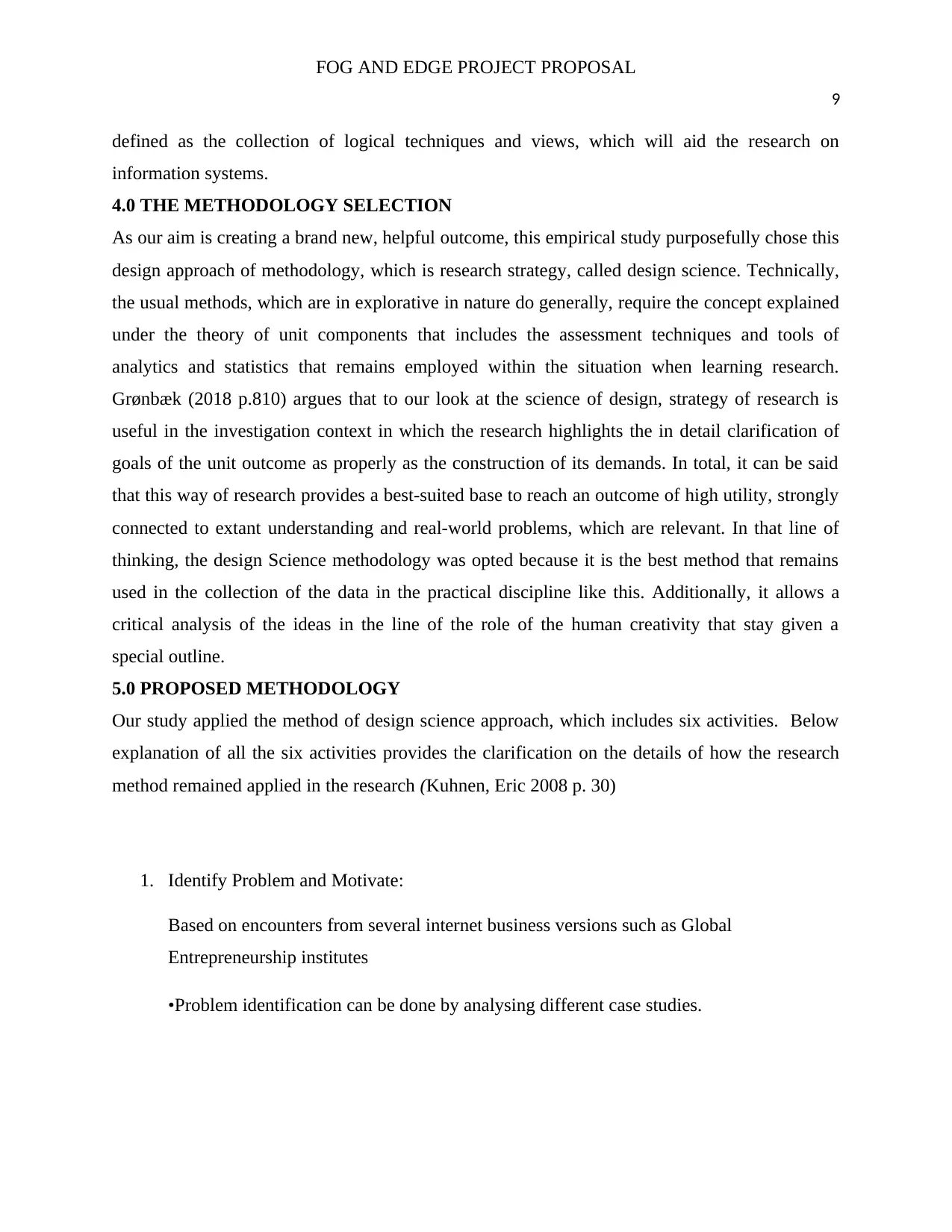
FOG AND EDGE PROJECT PROPOSAL
9
defined as the collection of logical techniques and views, which will aid the research on
information systems.
4.0 THE METHODOLOGY SELECTION
As our aim is creating a brand new, helpful outcome, this empirical study purposefully chose this
design approach of methodology, which is research strategy, called design science. Technically,
the usual methods, which are in explorative in nature do generally, require the concept explained
under the theory of unit components that includes the assessment techniques and tools of
analytics and statistics that remains employed within the situation when learning research.
Grønbæk (2018 p.810) argues that to our look at the science of design, strategy of research is
useful in the investigation context in which the research highlights the in detail clarification of
goals of the unit outcome as properly as the construction of its demands. In total, it can be said
that this way of research provides a best-suited base to reach an outcome of high utility, strongly
connected to extant understanding and real-world problems, which are relevant. In that line of
thinking, the design Science methodology was opted because it is the best method that remains
used in the collection of the data in the practical discipline like this. Additionally, it allows a
critical analysis of the ideas in the line of the role of the human creativity that stay given a
special outline.
5.0 PROPOSED METHODOLOGY
Our study applied the method of design science approach, which includes six activities. Below
explanation of all the six activities provides the clarification on the details of how the research
method remained applied in the research (Kuhnen, Eric 2008 p. 30)
1. Identify Problem and Motivate:
Based on encounters from several internet business versions such as Global
Entrepreneurship institutes
•Problem identification can be done by analysing different case studies.
9
defined as the collection of logical techniques and views, which will aid the research on
information systems.
4.0 THE METHODOLOGY SELECTION
As our aim is creating a brand new, helpful outcome, this empirical study purposefully chose this
design approach of methodology, which is research strategy, called design science. Technically,
the usual methods, which are in explorative in nature do generally, require the concept explained
under the theory of unit components that includes the assessment techniques and tools of
analytics and statistics that remains employed within the situation when learning research.
Grønbæk (2018 p.810) argues that to our look at the science of design, strategy of research is
useful in the investigation context in which the research highlights the in detail clarification of
goals of the unit outcome as properly as the construction of its demands. In total, it can be said
that this way of research provides a best-suited base to reach an outcome of high utility, strongly
connected to extant understanding and real-world problems, which are relevant. In that line of
thinking, the design Science methodology was opted because it is the best method that remains
used in the collection of the data in the practical discipline like this. Additionally, it allows a
critical analysis of the ideas in the line of the role of the human creativity that stay given a
special outline.
5.0 PROPOSED METHODOLOGY
Our study applied the method of design science approach, which includes six activities. Below
explanation of all the six activities provides the clarification on the details of how the research
method remained applied in the research (Kuhnen, Eric 2008 p. 30)
1. Identify Problem and Motivate:
Based on encounters from several internet business versions such as Global
Entrepreneurship institutes
•Problem identification can be done by analysing different case studies.
⊘ This is a preview!⊘
Do you want full access?
Subscribe today to unlock all pages.

Trusted by 1+ million students worldwide
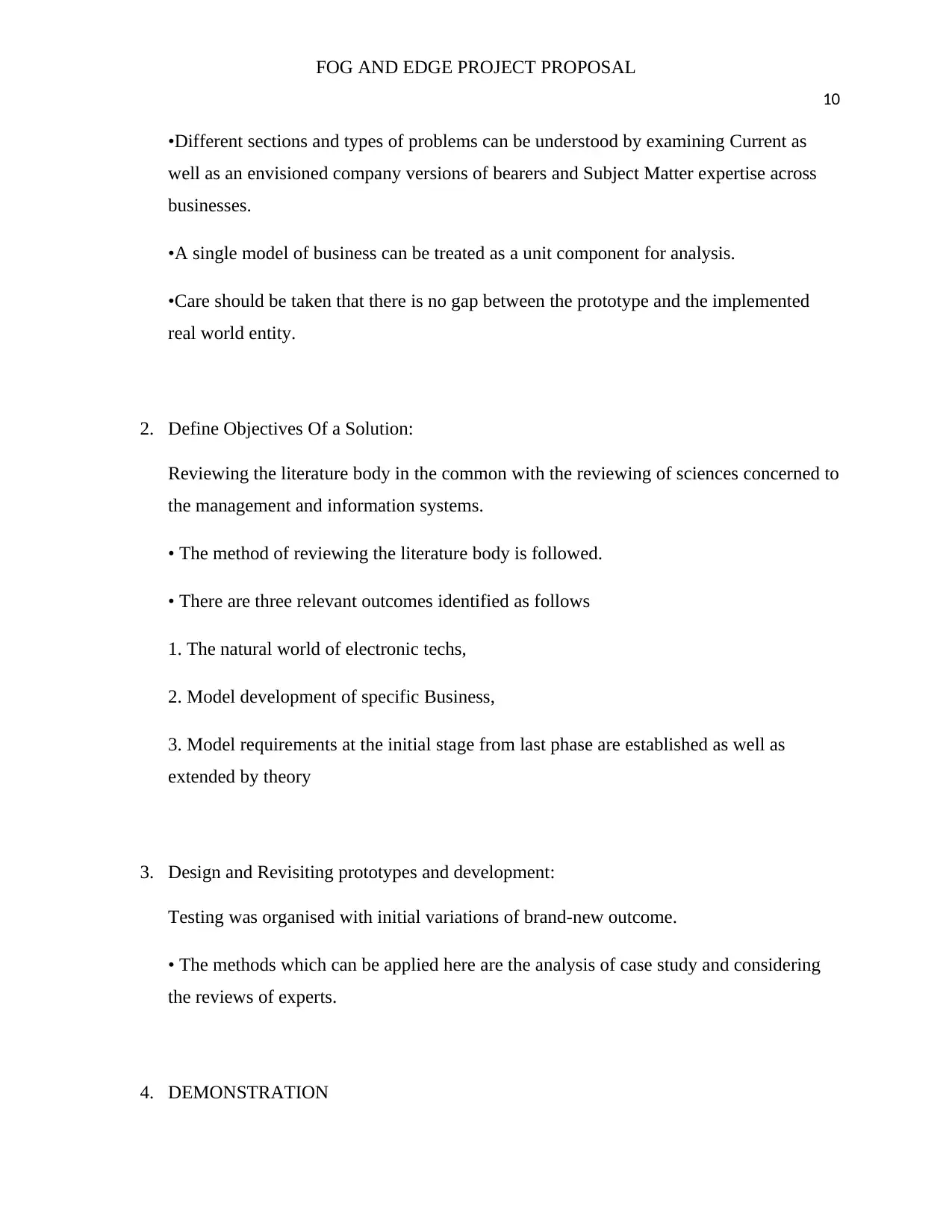
FOG AND EDGE PROJECT PROPOSAL
10
•Different sections and types of problems can be understood by examining Current as
well as an envisioned company versions of bearers and Subject Matter expertise across
businesses.
•A single model of business can be treated as a unit component for analysis.
•Care should be taken that there is no gap between the prototype and the implemented
real world entity.
2. Define Objectives Of a Solution:
Reviewing the literature body in the common with the reviewing of sciences concerned to
the management and information systems.
• The method of reviewing the literature body is followed.
• There are three relevant outcomes identified as follows
1. The natural world of electronic techs,
2. Model development of specific Business,
3. Model requirements at the initial stage from last phase are established as well as
extended by theory
3. Design and Revisiting prototypes and development:
Testing was organised with initial variations of brand-new outcome.
• The methods which can be applied here are the analysis of case study and considering
the reviews of experts.
4. DEMONSTRATION
10
•Different sections and types of problems can be understood by examining Current as
well as an envisioned company versions of bearers and Subject Matter expertise across
businesses.
•A single model of business can be treated as a unit component for analysis.
•Care should be taken that there is no gap between the prototype and the implemented
real world entity.
2. Define Objectives Of a Solution:
Reviewing the literature body in the common with the reviewing of sciences concerned to
the management and information systems.
• The method of reviewing the literature body is followed.
• There are three relevant outcomes identified as follows
1. The natural world of electronic techs,
2. Model development of specific Business,
3. Model requirements at the initial stage from last phase are established as well as
extended by theory
3. Design and Revisiting prototypes and development:
Testing was organised with initial variations of brand-new outcome.
• The methods which can be applied here are the analysis of case study and considering
the reviews of experts.
4. DEMONSTRATION
Paraphrase This Document
Need a fresh take? Get an instant paraphrase of this document with our AI Paraphraser
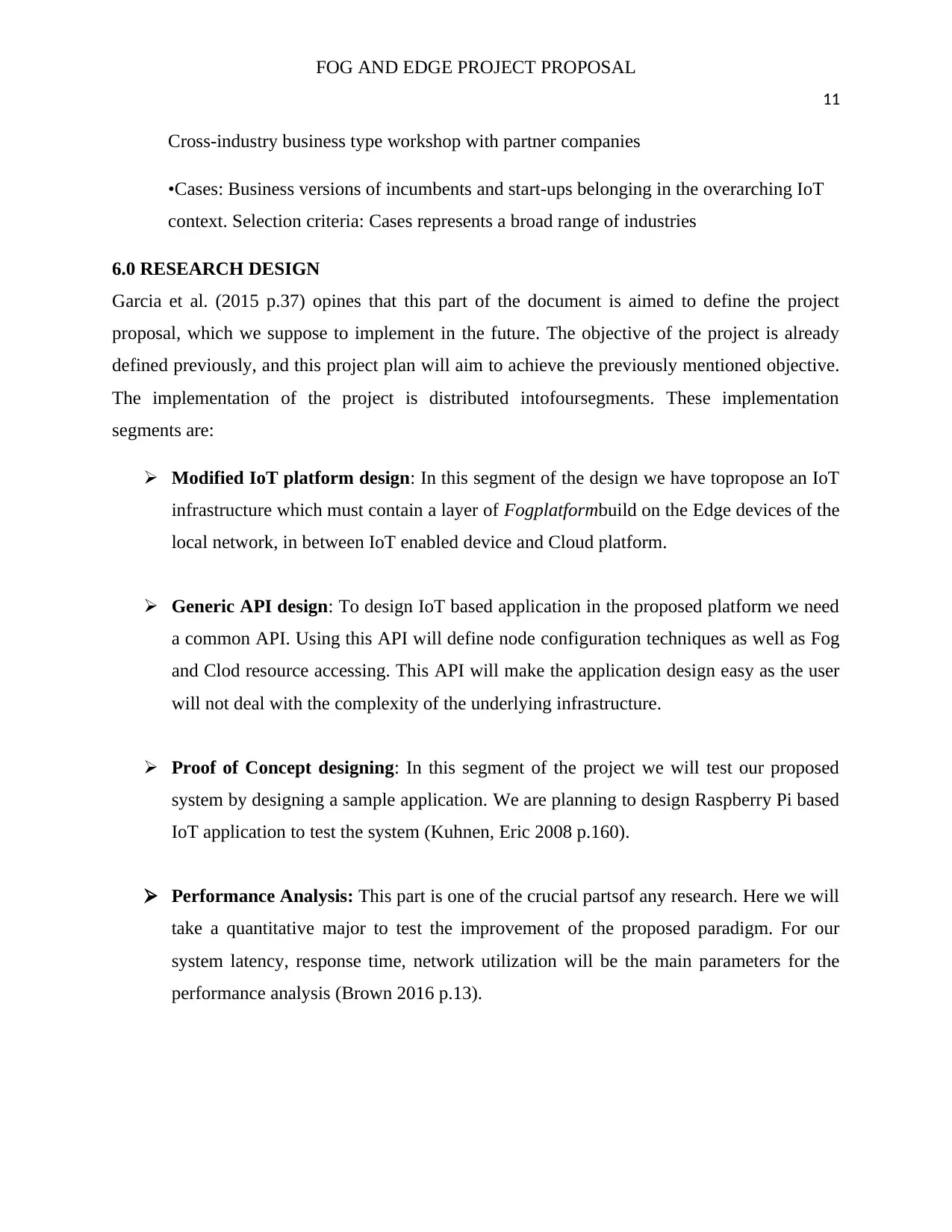
FOG AND EDGE PROJECT PROPOSAL
11
Cross-industry business type workshop with partner companies
•Cases: Business versions of incumbents and start-ups belonging in the overarching IoT
context. Selection criteria: Cases represents a broad range of industries
6.0 RESEARCH DESIGN
Garcia et al. (2015 p.37) opines that this part of the document is aimed to define the project
proposal, which we suppose to implement in the future. The objective of the project is already
defined previously, and this project plan will aim to achieve the previously mentioned objective.
The implementation of the project is distributed intofoursegments. These implementation
segments are:
Modified IoT platform design: In this segment of the design we have topropose an IoT
infrastructure which must contain a layer of Fogplatformbuild on the Edge devices of the
local network, in between IoT enabled device and Cloud platform.
Generic API design: To design IoT based application in the proposed platform we need
a common API. Using this API will define node configuration techniques as well as Fog
and Clod resource accessing. This API will make the application design easy as the user
will not deal with the complexity of the underlying infrastructure.
Proof of Concept designing: In this segment of the project we will test our proposed
system by designing a sample application. We are planning to design Raspberry Pi based
IoT application to test the system (Kuhnen, Eric 2008 p.160).
Performance Analysis: This part is one of the crucial partsof any research. Here we will
take a quantitative major to test the improvement of the proposed paradigm. For our
system latency, response time, network utilization will be the main parameters for the
performance analysis (Brown 2016 p.13).
11
Cross-industry business type workshop with partner companies
•Cases: Business versions of incumbents and start-ups belonging in the overarching IoT
context. Selection criteria: Cases represents a broad range of industries
6.0 RESEARCH DESIGN
Garcia et al. (2015 p.37) opines that this part of the document is aimed to define the project
proposal, which we suppose to implement in the future. The objective of the project is already
defined previously, and this project plan will aim to achieve the previously mentioned objective.
The implementation of the project is distributed intofoursegments. These implementation
segments are:
Modified IoT platform design: In this segment of the design we have topropose an IoT
infrastructure which must contain a layer of Fogplatformbuild on the Edge devices of the
local network, in between IoT enabled device and Cloud platform.
Generic API design: To design IoT based application in the proposed platform we need
a common API. Using this API will define node configuration techniques as well as Fog
and Clod resource accessing. This API will make the application design easy as the user
will not deal with the complexity of the underlying infrastructure.
Proof of Concept designing: In this segment of the project we will test our proposed
system by designing a sample application. We are planning to design Raspberry Pi based
IoT application to test the system (Kuhnen, Eric 2008 p.160).
Performance Analysis: This part is one of the crucial partsof any research. Here we will
take a quantitative major to test the improvement of the proposed paradigm. For our
system latency, response time, network utilization will be the main parameters for the
performance analysis (Brown 2016 p.13).

FOG AND EDGE PROJECT PROPOSAL
12
12
⊘ This is a preview!⊘
Do you want full access?
Subscribe today to unlock all pages.

Trusted by 1+ million students worldwide
1 out of 17
Related Documents
Your All-in-One AI-Powered Toolkit for Academic Success.
+13062052269
info@desklib.com
Available 24*7 on WhatsApp / Email
![[object Object]](/_next/static/media/star-bottom.7253800d.svg)
Unlock your academic potential
Copyright © 2020–2025 A2Z Services. All Rights Reserved. Developed and managed by ZUCOL.





